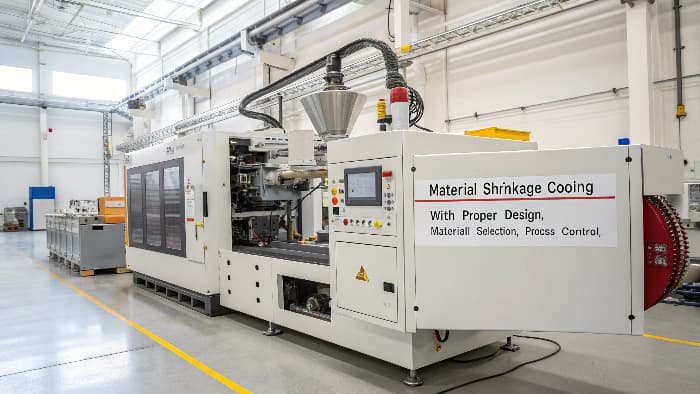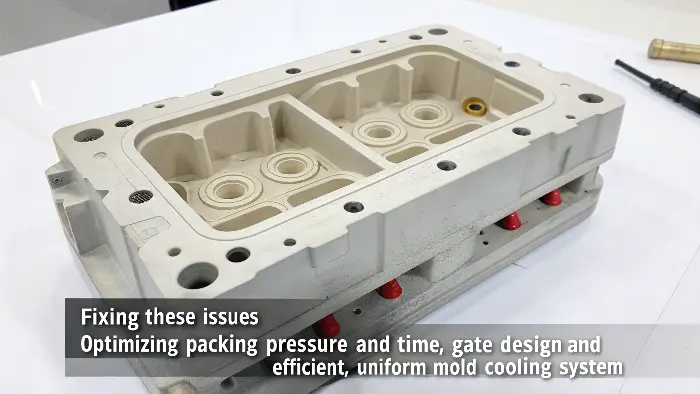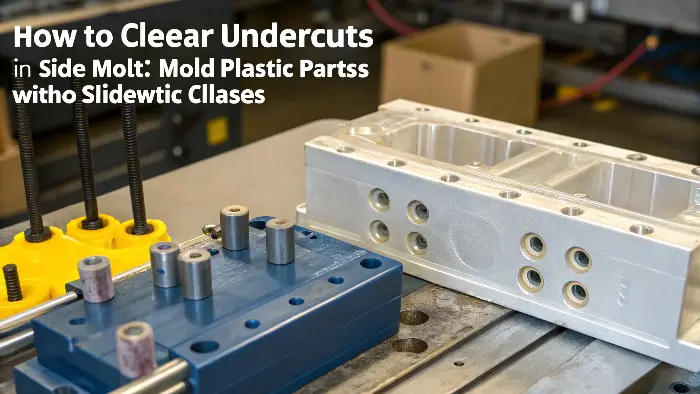Struggling with plastic parts warping or not fitting right? This can be a real headache, costing time and money. We at CKMOLD have a plan to fix that.
CKMOLD tackles complex part deformation through meticulous material selection, advanced mold design focusing on uniform cooling and structural integrity, and precise process control. This ensures your parts meet exact specifications, every single time.
Transition Paragraph:
Getting those perfect, non-deformed parts, especially the complex ones, isn’t just luck. It’s about a systematic approach, something we’ve refined over years. I’ve seen so many businesses, just like Michael’s, grapple with this. They need reliable parts, and deformation is a major roadblock. So, let’s dive into how we, at CKMOLD, tackle this head-on, breaking down the common questions and our solutions. You’ll see it’s all about understanding the fundamentals and then applying smart design and material choices. Keep reading, because this could change how you view your molding challenges.
What is the Injection Mould Technique, and Why Does Mastery Matter for Part Quality?
Ever wonder how those intricate plastic parts are made so consistently? It often boils down to the injection molding technique. But if it’s not done right, you get all sorts of problems, including deformation.
The injection mould technique involves melting plastic, injecting it under high pressure into a precisely engineered mold, and then cooling it to form a solid part. Mastering this technique is crucial for consistent part quality and minimizing defects like deformation.
Dive deeper Paragraph:
I often tell people, like Michael, that understanding the core injection molding technique is the first step. It’s not just squishing hot plastic into a shape; it’s a pretty sophisticated dance of physics and chemistry. At CKMOLD, we see it as a craft. The process, in simple terms, goes like this:
- Clamping: The two halves of the mold are securely closed.
- Injection: Molten plastic is injected into the mold cavity under high pressure.
- Cooling: The plastic cools and solidifies, taking the shape of the mold.
- Ejection: The mold opens, and the part is ejected.
Sounds straightforward, right? But here’s the kicker: every step has variables that can affect the final part. Pressure, temperature, speed, material behavior – they all play a role. If these aren’t spot on, you’re looking at potential issues. That’s why, for us, "Master Molding Right" isn’t just a slogan; it’s about controlling these variables. This control starts way before the machine even hums. It starts with understanding the material you’re working with – how it flows, how it shrinks. This early material insight is key to preventing deformation later. It’s like building a house; you need a solid foundation. For injection molding, that foundation is a deep understanding of the technique and the materials.Key Stages and Control Points
Stage Key Control Parameters Impact on Deformation Injection Injection speed, pressure, melt temp Affects fill pattern, internal stresses Packing/Holding Packing pressure, packing time Compensates for shrinkage, prevents voids Cooling Coolant temp, cooling time, channel design Governs shrinkage rate and uniformity Ejection Ejection speed, force, part design Can induce stress if not optimized This precision at each stage is what we focus on at CKMOLD.
Is Injection Molding Inherently a Deformation Process?
You might be thinking, "If the technique is so precise, why does deformation still happen? Is the process itself flawed?" It’s a fair question I get a lot.
Yes, to some extent, injection molding involves processes like material shrinkage during cooling, which can lead to deformation if not expertly managed. However, with proper design, material selection, and process control, deformation can be minimized or eliminated.

Dive deeper Paragraph:
So, here’s the deal: plastic shrinks when it cools. It’s just physics. Different plastics shrink at different rates, and even the same plastic can shrink differently depending on how thick or thin a section is. This "differential shrinkage" is a major bad guy when it comes to warping and twisting. If one part of your component cools and shrinks faster or more than another, it’s going to pull and distort the shape. That’s the "deformation" part.
But here’s where CKMOLD’s systematic approach shines. We don’t just accept deformation as inevitable. We fight it with smart strategies. My journey in this industry, from the factory floor to running my own company, taught me that anticipation and proactive design are everything.CKMOLD’s Anti-Deformation Strategies
- Material Selection is King:
- We start by choosing materials with low and uniform shrinkage. Think materials like glass-filled ABS or Polycarbonate if the application allows. Sometimes, a slightly more expensive material upfront saves a fortune in rejected parts and assembly headaches. I always advise clients like Michael to consider the total cost of ownership, not just the raw material price.
- We also use material testing and flow simulation software. This isn’t just fancy tech; it helps us predict how a specific plastic will behave in your specific part design under real molding conditions. It’s like having a crystal ball, but, you know, more scientific!
- Mold Design – The Blueprint for Success:
- Uniform Wall Thickness: This is a golden rule. If you have a part with a thick section next to a thin one, the thick section will cool slower and shrink more, causing warp. We work with designers to achieve as uniform a wall thickness as possible.
- Proper Draft Angles: These slight tapers on the part walls make it easier to eject the part from the mold. Without them, the part can stick, and the ejection forces can literally bend it out of shape.
- Strategic Ribs and Gussets: Instead of making walls thicker (which causes problems), we can add ribs or gussets to provide strength and stiffness. Placed correctly, they help the part maintain its shape during cooling.
It’s this kind of detailed thinking that turns a potential "deformation process" into a controlled manufacturing method.How Can We Tackle Pesky Voids in Injection Molded Parts?
Okay, so we’re working on overall shape, but what about those annoying little sink marks or, worse, internal voids? They’re not just ugly; they can weaken the part. This is a common worry for folks aiming for top-notch quality.
Voids in injection molding are often caused by insufficient material packing or uneven cooling. Fixing them involves optimizing packing pressure and time, gate design, and ensuring an efficient, uniform mold cooling system.

Dive deeper Paragraph:
Voids and sink marks – they’re like little pockets of nothing where there should be solid plastic. They typically happen when the outer surface of the plastic part cools and solidifies while the inside is still molten and shrinking. As that internal plastic shrinks, it pulls the outer surface inward (a sink mark) or creates an internal bubble (a void). It’s a real challenge, especially in thicker sections of a part.
I remember a project for a client making consumer electronics enclosures. Voids were causing structural failures – not good! We had to get to the root cause. Here’s how we generally approach this at CKMOLD, and it ties back into our overall strategy for part integrity:Key Approaches to Eliminating Voids:
- Optimizing Packing Pressure and Time: After the initial injection fills the mold, we apply "packing pressure." This forces more material into the cavity to compensate for shrinkage as the plastic cools. Getting the pressure right, and holding it for the right amount of time, is critical. Too little, and you get voids. Too much, and you can overpack, causing other issues like flash or stress.
- Tertiary Heading Example: The Role of Gate Design
Gates are the openings through which plastic enters the mold cavity. Their size and location are super important. If a gate freezes off too early, you can’t pack out the part properly, leading to voids. We often use simulations to optimize gate design for this very reason. - The Magic of Mold Cooling: This is a big one, and it directly relates to preventing deformation too.
- An efficient cooling system in the mold is paramount. We design cooling channels that are close to the plastic and ensure uniform temperature distribution across the mold. Sometimes, this means using advanced techniques like conformal cooling, where the cooling channels follow the contours of the part. This helps the entire part solidify at a more even rate, reducing the chances of voids forming in those last-to-cool thick spots. It’s an investment, but for complex parts, it often pays for itself by reducing defects and cycle times. Think of it like this: even cooling means even shrinkage, which means fewer voids and less warping. It all works together.
It’s this detailed attention to both process parameters and mold design that helps us deliver void-free, high-quality parts.How Do You Effectively Clear Undercuts in Plastic Parts Without Causing Issues?
Now, let’s talk about complex features. What if your part design has undercuts – like clips, snaps, or side holes? These can be tricky because they prevent the part from being ejected straight out of a simple two-half mold. Mess this up, and you could be looking at damaged parts or even a damaged mold.
Undercuts in plastic parts are cleared using mold mechanisms like sliders, lifters, or collapsible cores. The key is designing these actions precisely to release the undercut feature smoothly before or during ejection, preventing stress and deformation.

Dive deeper Paragraph:
Undercuts are features that are, well, "under" the direct line of pull when the mold opens. Imagine trying to pull a J-shaped hook straight out of a block of ice it’s frozen into – it won’t work. You need a way to move the ice (or the mold part) out of the way of the hook first. That’s what we do with undercuts in injection molding. This is where mold design gets really clever. I’ve seen clients like Michael, who need functional snaps or interlocking features, really benefit from well-thought-out undercut solutions.
At CKMOLD, we treat undercuts not as problems, but as design challenges that require elegant solutions. The goal is always to create the feature reliably and ensure the part comes out perfectly, without any added stress or deformation.Common Mechanisms for Handling Undercuts:
Mechanism Description Best Suited For Considerations Sliders (Slides) Moving mold components that retract sideways to clear external undercuts. External features like clips, holes, bosses. Adds complexity and cost to the mold, requires space. Lifters Angled components within the mold that move with the ejection system to push and release internal undercuts. Internal features, snaps, small openings. Can leave slight witness marks, limited travel. Collapsible Cores Complex mechanisms where parts of the core collapse inward to release deep or intricate internal undercuts. Threads, complex internal geometries. Most complex and expensive, high precision needed. Manual Inserts (Hand Loads) Separate mold pieces manually placed and removed for each cycle. Low volume, very complex or deep undercuts. Slows cycle time, increases labor. The choice of mechanism depends on the undercut’s geometry, size, location, and, of course, production volume. But more than just choosing a mechanism, it’s about the design and integration of that mechanism. For example, a slider needs to move smoothly, lock securely, and not interfere with cooling or part ejection. The forces involved during the actuation of these mechanisms must be managed so they don’t distort the still-warm plastic part. This ties back to ensuring good draft angles even on features created by sliders or lifters, and sometimes incorporating ribs or gussets to support areas around undercuts to prevent them from deforming during the ejection sequence. It’s a bit like a puzzle – all the pieces have to fit and work together perfectly. That’s how we ensure even parts with complex undercuts come out looking great and functioning as intended.
Conclusion
So, eliminating deformation in complex injection molded parts isn’t magic. It’s about a systematic CKMOLD approach: smart material choices, meticulous mold design, and precise process control, all working together for your success.
